Wire dog crates are an essential part of keeping your dog safe and comfortable. But how are they made? This article will take you through the entire manufacturing process, from start to finish. You will learn about the different materials used to make wire dog crates and see the entire process in action.
The author has been working in a dog crate factory for almost 10 years and knows the wire dog crate manufacturing process backward and forwards, and all the information in this post is based on first-hand experience.
It all starts at the source
The raw materials arrive at the factory and are stored in a warehouse until they are needed. There are three types of raw materials for wire dog crates: wire, iron sheets, and plastic.
Iron wire
The wire arrives at the factory in large coils ready for the next step in the process, which will eventually be processed into mesh and doors.
Iron sheet
Said to be iron sheets, the actual iron sheets have been processed into clasps for attaching the mesh.
Plastic
The plastic is used to make the tray at the bottom of the dog crate, and the factory purchases the tray back already as a finished product. Special note, some customers will require the use of metal pallets, in this case, the raw materials of the dog crate are only wire and iron sheets.
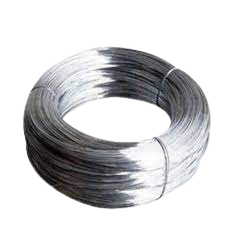
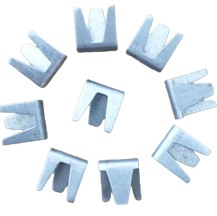

Processes
The processing process of the wire dog crate factory is mainly for the wire part. The main processes are straightening, cutting, bending, welding, trimming, assembling, buckling, surface treatment, boxing, and sealing.
Straightening
Different models of wire dog crates use different wire diameters. In addition, there are several wire diameters used in a dog crate. To ensure the quality of the finished product, it is important to use wire of the same diameter. In order to achieve this, the wire must first be straightened. This process involves the use of a wire straightening machine. A section of wire is placed in the straightening machine and after the machine has been processed, the bent wire becomes straight.
Cutting
The cutting process follows the straightening. The desired length is pre-set and the wire is cut to the desired length directly after it is straightened. The same length of wire is placed in the same container.
Bending
Dog cage wire is not always straight, there are places to use bent wire, such as the turn of the frame. Straightened and cut wire into the bending machine, preset the length and radius of bending, the straight wire will be bent into the corresponding bent wire. Again, put it centrally into a new container and set them aside.
Welding by Hand/Spot Welding
The welding process is used to join two or more pieces of wire together. This is an important step in the manufacturing process as it forms the mesh structure that makes up the dog cage. In this process, for the accuracy and quality of the finished product, the master needs to make a mold in advance to match the size and shape of the wire mesh. Once the mold is made, the wire is placed into it and welded together.
Welding by Machine
Depending on the number of orders, the factory usually uses touch welding, which is done by hand. For some particularly large orders, the factory will also use a line welder, which uses high frequency current to weld the wire together, it will be much more efficient and the quality of the mesh made will be much higher, not easy to desolder and the appearance will look neat and tidy.
Trimming
After a single wire is made into a mesh by welding, the top of the wire will actually be a little bit beyond the frame, which is intentionally reserved more to prevent the whole mesh from being unusable due to the short length of a certain wire. If the wire is a little bit longer, it can be trimmed, but if it is a little bit shorter, the whole thing will be scrapped. The worker uses a trimming machine to cut off the excess wire so that the whole edge of the mesh becomes smooth and does not hurt the hand.
Buckling
The other parts that need to be connected are connected by means of clasps, as described above. The raw material for the clasp is an iron sheet, which has its own unique shape when it is first purchased back. Put the wire on the side of the two pieces of mesh that need to be connected, put it on the iron sheet, and then use the air gun to act on the buckle, the result is that the two wires are wrapped by the buckle and can be turned inside. After using the same method to play more clasps, the two pieces of mesh are connected and can be rotated at the same time. After this process, the entire frame of the dog cage is basically complete.

Surface treatment
There are various finishes for dog crates, and different finishes are sent to different processing plants and pulled back to the workshop after the process is completed. Please see the table below for details.
Treatment | Electrophoresis | Plastic spraying | Electroplating |
| Processes | Using the principle of electrolysis on the surface of the dog crate coated with a layer of resin. | Spraying paint onto the surface of the dog crate, the powder will be evenly absorbed, forming a powder coating. | Using the principle of electrolysis on the surface of the dog crate coated with a layer of metal. |
| Colors | Black | Available in multiple colors | Silver |
| Processing costs | A | AA | AAA |
| Years of use | 1-2 years | 2-3 years | 4-5 years |
| Remarks | The cheapest of the three, with only black color available. | The price is moderate, with a wide selection of colors, and colored dog crates are also made in this way. | The most expensive of the three, for dog crates, basically galvanized, the product is silver after treatment. |
Boxing
After the above process, the frame part of the dog crate is completed. The process of putting the dog crate frame into the outer box together with other accessories is called boxing. These accessories are trays, plastic handles, instructions. The process is like this, first unfold the cage, put the tray into the bottom of the cage, put the manual and the handle on the tray, then fold the cage back, and finally put it into the master carton.
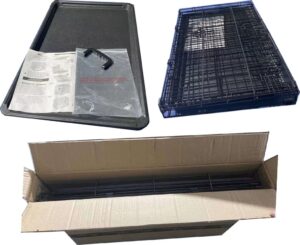
Sealing
The master carton used for the dog crate is a standard mail-order carton, a five-layer double corrugated brown box. Customers can also customize their own cartons, such as thicker cartons, and use a white carton, etc. After the product and all the accessories are put into the master carton, the process of sealing the opening carton with transparent tape is called sealing the box. The factory usually adopts the “I” type sealing method. The overall weight of the dog cage is not large, and it is a whole unit, no need to use sealing reinforcement tape.s straightened. The same length of wire is placed in the same container.
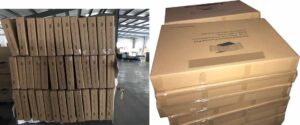
Special Processes
The factory meets a variety of customers of all sorts every year, and each customer has different requirements for their products. The following section introduces the more common special processes for wire dog cages.
Adding customer Logo onto the product
In order to expand the influence of the company’s brand, in addition to printing the customer’s logo onto the master carton, some customers will also choose to stick their own company logo onto the product. For wire dog cages, the common way to add a logo is to first weld a 90*40cm size iron sheet on side of the cage, and then stick the customer’s logo on this iron sheet.

Adding dividers
To meet the needs of different end-users, some wholesalers will purchase additional dog crate dividers and bottom plates. The divider is used to divide the crate into different parts, and the bottom plate is installed at the bottom of the crate, where the pet will stand directly on it, reducing the chance of contact between the pet’s limbs and their excrement.

Adding rollers
Similarly, you can also add plastic wheels at the bottom of the dog crate, equivalent to adding wheels to the crate, more convenient to move the larger weight of the crate, but also to protect the home floor or carpet.
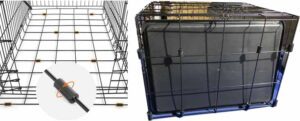
Quality control and proper storage
Inspection is a necessary step after the completion of the large shipment. Usually, when 80% of the large shipment is completed, the factory will notify the customer to arrange an inspection. If the customer has a branch in China, he can arrange someone from the branch to come and inspect the goods. If he does not have a branch, he can pay a certain fee to have the goods inspected by a third party. It is also acceptable to let the factory help to inspect the goods, but if there are minor problems with the inspection, the factory will arrange the rework itself and will not inform the customer.
Samples selecting
After the mass production is completed, a responsible factory will have a process of inspection before shipment. To begin with, randomly select samples, the quantity is 5% of the whole order, and place the samples on the inspection table.
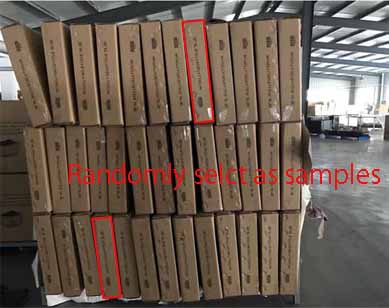
Dorp testing
Drop testing is a common quality assurance procedure used to test the strength and durability of a product. Factories that are in a position to do so will use drop test machines. It is dropped from a certain height onto a hard surface to see if it can withstand the impact. According to international standards, for wire dog crates, the drop height is 76 cm. 10 times in accordance with the “one point, three lines, six sides” approach, if the crate does not break or damage, it will pass the test. Normally, using standard mail-order cartons, and the product itself is OK, there is no problem to pass the test.
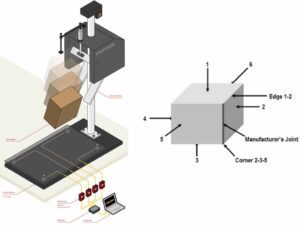
Checking before assembling
First, check whether the markings on the outer carton are consistent with the markings document provided by the customer. Then measure the length, width, and height of the carton, as well as the overall weight, to see if they are consistent with the values on the PI. Unpack the carton, take out all the accessories, weigh them, the term above is called the net weight of the product, check whether the value is consistent with the PI. Verify that the number of accessories is consistent with the instructions.
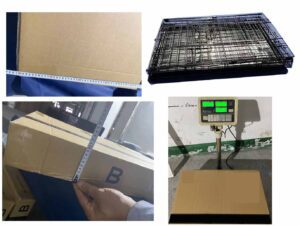
Checking after assembling
Check the appearance of the sample, whether there are burrs, paint loss, and fewer accessories. Manually open and close the door to check whether the door closes smoothly and the lock closes smoothly. Measure wheth
Use vernier calipers to measure the wire diameter, check the value, and do not allow too much error. Some factories will use smaller wire diameters to reduce the cost, which can not be seen with the naked eye.
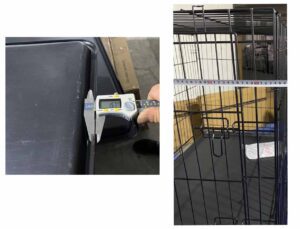
Data retention
All of the above steps need to take pictures or videos to keep for records. After the shipment, once the problem is found, it can be traced back to the source. It is possible to determine whether the problem was not found by the lack of careful inspection and to determine whether the problem is a batch or just a case. Finally, according to the actual inspection, make an inspection report and send it to the customer together with the inspection information. The customer will decide whether the goods can be shipped normally.

Proper storage
The next step is to arrange the shipping. There is usually a period of time between the completion of the mass production and the loading of the container. During this time, the goods are usually stored in the factory’s finished goods warehouse. The correct storage method is to place the goods on pallets, cover them with tarpaulins and avoid direct sunlight or rain. The relative humidity of the air should be controlled at about 60% and ventilation should be ensured to avoid the cartons from absorbing moisture. Take care to prevent a collision when loading onto the pallets so as not to damage the appearance of the goods.
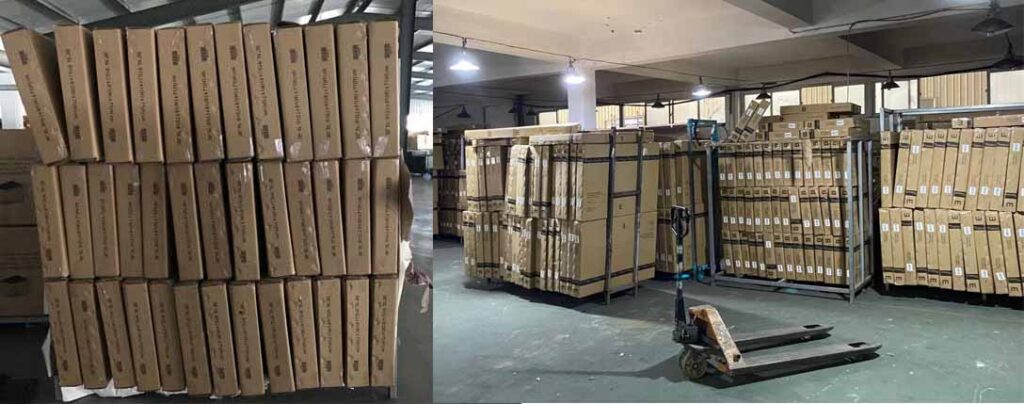
Conclusion
It usually takes about 35 days from ordering raw materials to have the mass production completely ready. The whole process does not require high precision instruments and equipment, but each process is also essential. The sample inspection and storage of the goods should be attached more importance.
Once there is a problem with the sample inspection, we need to communicate with the customer in time to discuss how to rework and complete the rework in the shortest possible time to ensure the customer’s delivery date. It is not recommended to ship the goods directly without inspection. Say the goods are transported overseas, once the problem occurs, it is bulk, the loss caused is much higher than the cost of reworking in the factory. Moreover, the factory and the customer are likely to have disputes because of the division of responsibility, that is, the bad impact of the customer’s brand power, but also a waste of valuable time, the factory will also lose this customer.
Storage of the goods can not be ignored either. It takes time and hard work to make, if the storage is not good and leads to scrap, the previous work will be all in vain.
Therefore, wholesalers in the selection of factories should choose a responsible factory, not to say a large scale, but at least have a decent workshop and warehouse. Mutual benefit and win-win cooperation between the two sides.


